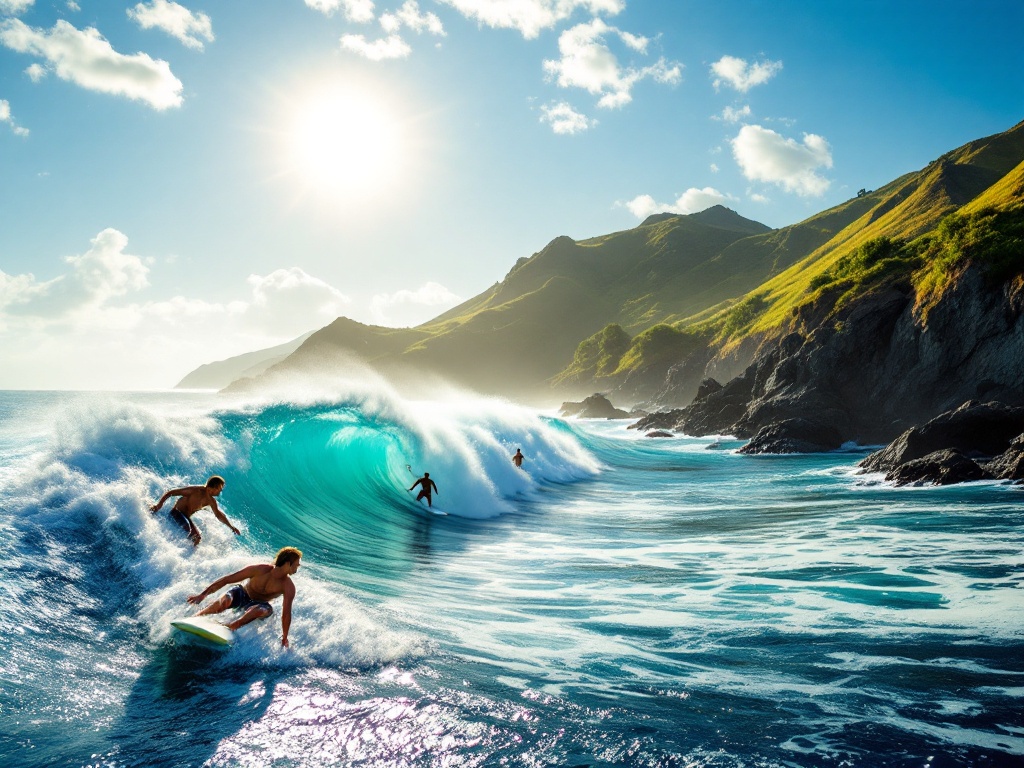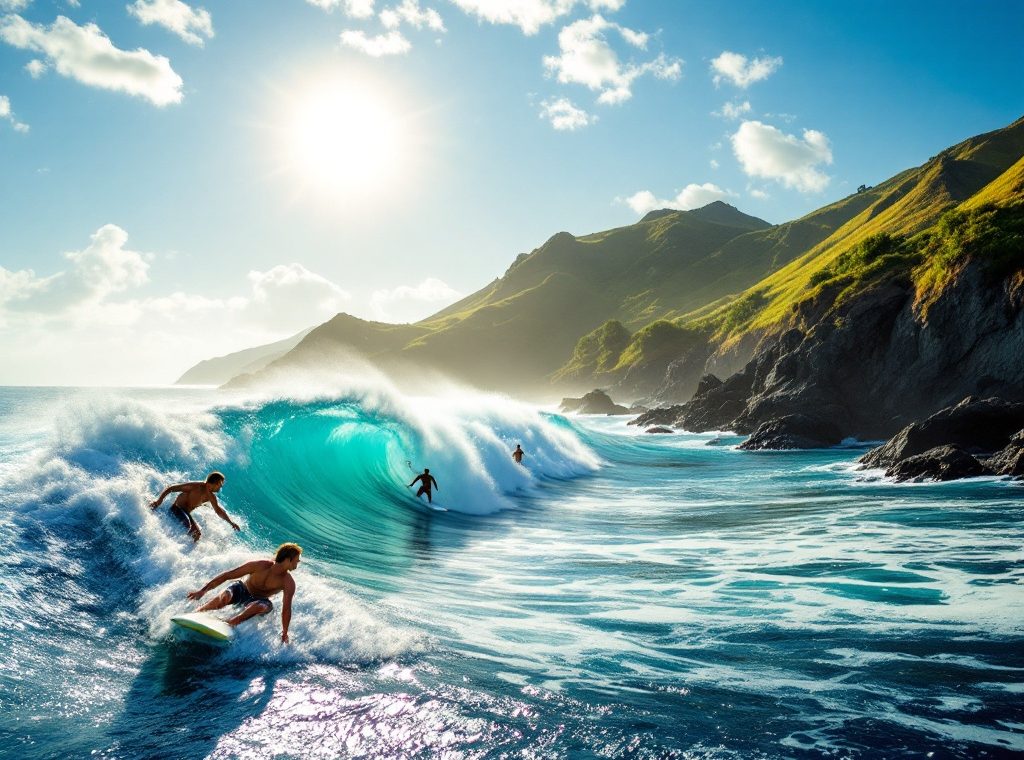New Zealand for Surfers: Bay of Islands Tides
Want to catch the perfect wave in New Zealand’s Bay of Islands? Knowing the tides is key! High tides around 3 AM and 3 PM bring powerful swells reaching 2.24 meters, ideal for experienced surfers. But beware of low tides (around 9 AM and 9 PM) as rocks and reefs become exposed. For a safe and exhilarating surf, check tide charts before you go and discover top spots like Te Tii and Paihia. Plan your Bay of Islands surf trip now and ride the best waves!
Important information

- Tides in the Bay of Islands change about every six hours and greatly affect surfing.
- Mid to high tide is best for surfing, with stronger waves.
- Low tide reveals rocks and reefs, making it dangerous.
- Always check tide charts and wind maps before you surf.
- Surf with a buddy and wear a wetsuit for safety.
New Zealand for Surfers: Bay of Islands Tides
Bay of Islands tide times shift approximately every six hours, significantly impacting surf conditions. Checking tide charts before heading out is crucial. Mid to high tide generally offers more powerful waves and is the preferred time for surfing. Conversely, low tide can expose rocks and reefs, creating hazardous conditions. Be mindful of these submerged obstacles becoming visible during low tide, as they pose a safety risk. Therefore, understanding the tide is essential for both a safe and enjoyable surfing experience. Plan your trip accordingly. Here’s a guide to help you plan your surfing trip around the tides:
Mid to High Tide
Offers more powerful waves. This is the preferred time for surfing, providing a more exhilarating experience.
Low Tide
Exposes rocks and reefs. Creates hazardous conditions for surfing. Submerged obstacles become visible, posing a safety risk.
Understanding the Bay of Islands Tides
Understanding the tides is crucial for surfers in the Bay of Islands. The bay experiences two high and two low tides daily. High tides reach 2.24 meters, while low tides recede to 0.63 meters. Expect a high tide at 3:06 AM and another at 3:24 PM. Low tides occur at 9:14 AM and 9:40 PM. These tidal shifts significantly impact wave conditions. To catch the best breaks, consult a tide chart before paddling out.
High and Low Tide Times
High tides in the Bay of Islands arrive at 3:06 AM and 3:24 PM. Low tides occur at 9:14 AM and 9:40 PM. These tidal changes significantly impact surfing conditions. Some breaks are optimal during high tide, while others are better during low tide. Knowing the tides is essential for a good surfing experience.
Impact of Tides on Surfing Conditions
Tides significantly influence surf conditions in the Bay of Islands. High tide brings powerful, steep waves, perfect for experienced surfers. Low tide exposes rocks and reefs, creating dangerous conditions. Because some breaks are accessible only at certain tide levels, checking tide charts is essential for safety and choosing the best waves.
Surfing in the Bay of Islands
The Bay of Islands is a surfer’s paradise, offering diverse experiences. However, tide times and weather significantly influence wave conditions. Consulting tide charts and wind maps is essential for a successful session. These resources provide crucial information about wave conditions and potential hazards. Surf alerts and safety tips are also vital for ensuring a safe and enjoyable experience.
Popular surf spots
- Te Tii Beach: known for consistent surf.
- Paihia Beach: offers gentler waves, perfect for beginners.
- Cape Brett: renowned for its challenging breaks, suited for experienced surfers.
Planning your session
The northern end of the bay presents unique surfing conditions, ensuring something for all skill levels. From the reliable swells of Te Tii to the beginner-friendly waves at Paihia, the options are plentiful.
Popular Surf Spots and Wave Height
Tide height significantly influences surf conditions in the Bay of Islands. A high tide, such as the 2.24-meter crest, can considerably impact wave quality. Checking tide charts is essential for surfers seeking optimal conditions and a truly enjoyable experience.
Utilizing Tide Charts and Wind Maps
Bay of Islands tide charts reveal the ebb and flow of the ocean, providing crucial information for surfers. When combined with wind maps, these charts help pinpoint prime wave conditions. For example, an outgoing tide paired with a gentle offshore breeze often creates ideal surfing conditions.
Surf Alerts and Safety Tips
Surfing the Bay of Islands is exhilarating, but safety should always be your top priority. Understanding local conditions is key, so check tide schedules before heading out. Low tides can reveal hazardous rocks and reefs, while currents and wave heights impact your experience. A wetsuit provides essential warmth, and a leash keeps your board from drifting away. Never surf alone; a buddy adds an extra layer of safety. If you’re unfamiliar with the area, chat with local surfers – they’re a wealth of information. Here’s a guide to ensure a safe and enjoyable surfing experience:
Check the tide schedule. Low tide can expose dangerous rocks and reefs, while strong currents and high waves can make surfing difficult.
Wear a wetsuit. The water can be cold, even in summer, so a wetsuit will help you stay warm and comfortable.
Use a leash. A leash will prevent your board from drifting away if you fall off, which can be especially important in strong currents.
Never surf alone. Having a buddy with you increases safety in case of an emergency.
Talk to local surfers. Local surfers can provide valuable insights into the area’s specific conditions, hazards, and best surfing spots.













